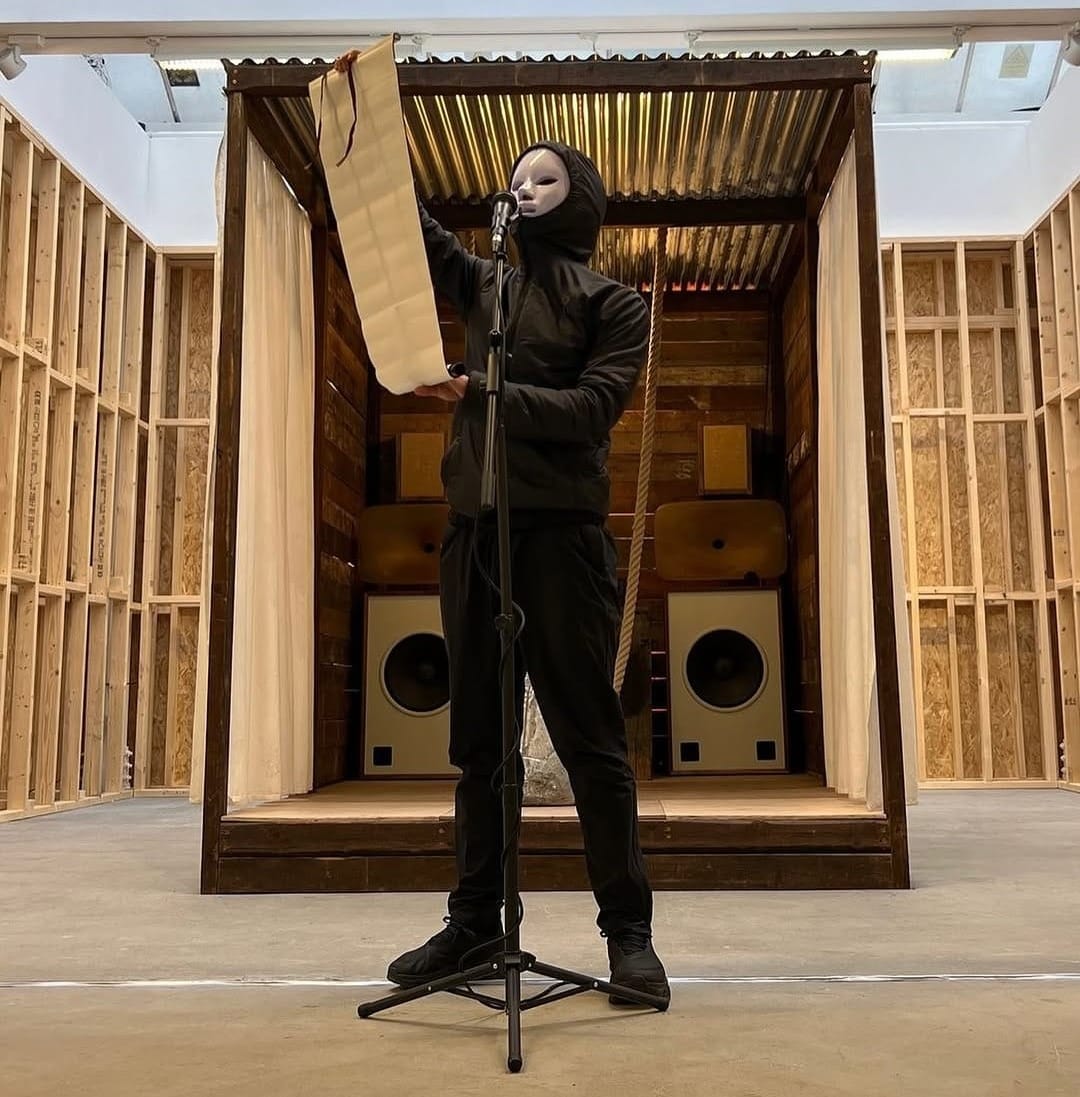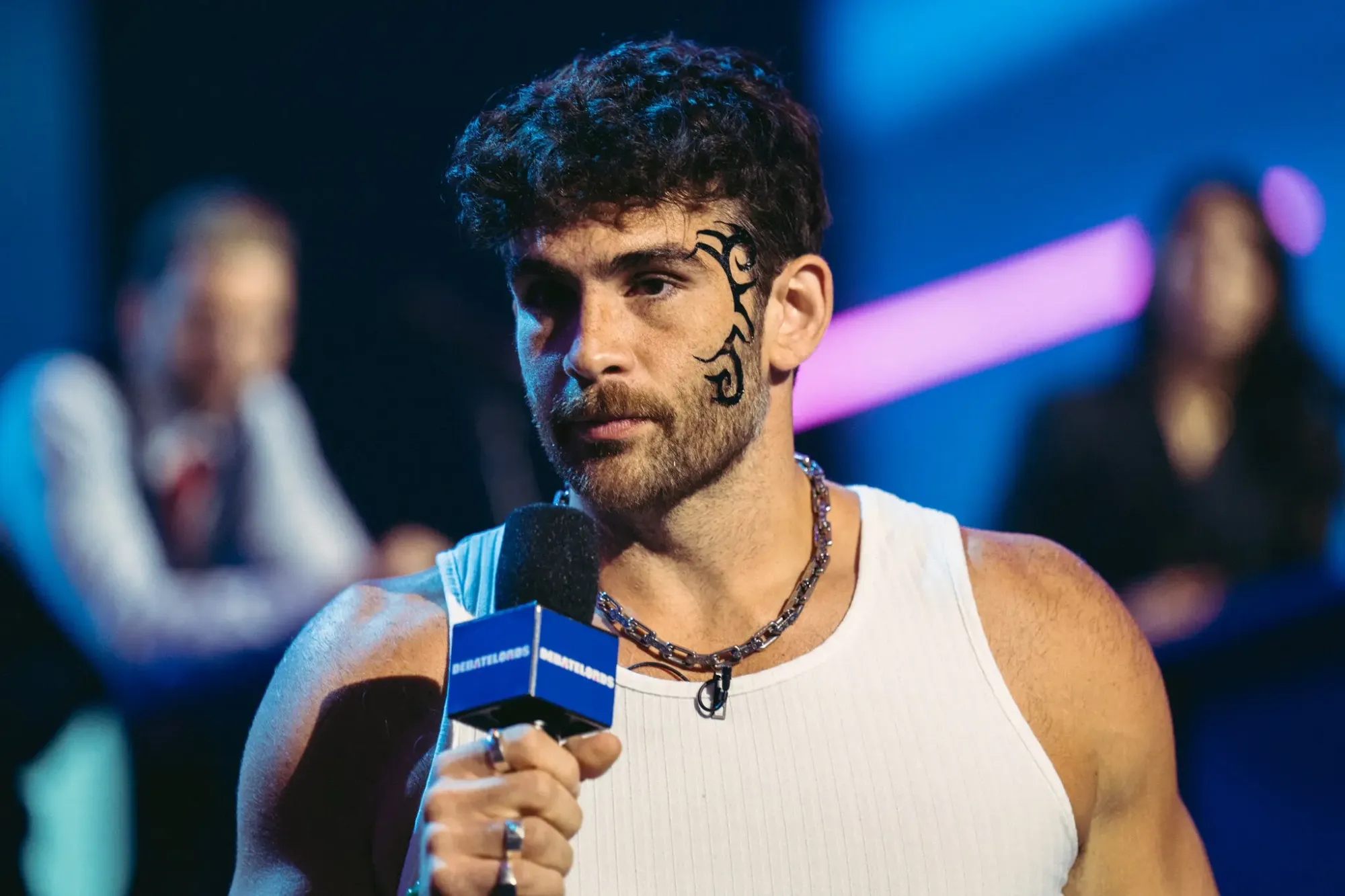
Corbin Shaw, wearing black trainers, tracksuit bottoms and a jacket with the hood pulled up, stood in front of a microphone at Sadie Coles HQ gallery in central London. His face was hidden behind a white mask as he unfurled a scroll and began reading to an audience in the hundreds.
This was the latest instalment of Gargle, an invitational programme of monthly live events. The poetry group Adult Entertainment co-hosted alongside the gallery. Shaw titled his piece “Doomscroll Performance,” featuring lines such as: “My testosterone levels are high but I still don’t have any striking masculine characteristics. Could it be my genetics fault?”

The Sheffield-born artist, now in his mid-20s, is both a product and a critic of the world that shaped him. His powerful live performance interrogated masculinity and identity, echoing the broader themes explored in his better-known textile works. In these pieces, he subverts traditional British narratives, using football terrace language to challenge inherited ideas of masculinity. His reimagined St George’s flags feature slogans such as “Soften Up Hard Lad,” “I’m Never Going to Be One of the Lads” and “Sweet and Tender Hooligan”.
Shaw’s art is not a rejection of the past, but a reckoning with it: a recognition that the boxing gyms, football stadiums and pubs that once offered men sanctuary and solidarity can also be crucibles for conflict and toxicity. His work, embroidered with tabloid slogans and the iconography of working-class pride, asks viewers to look again at what it means to be a man in a country where the old certainties – jobs for life, houses to buy, roles to inhabit – have slipped away.
In the past, Shaw has talked about how his practice is not merely aesthetic; it is therapeutic, both for himself and for those who see themselves reflected in his work. He is part of a wave of young men who are challenging the stigmas around mental health, who are willing to admit that the old ways of coping – bottling up pain, masking fear with aggression – are no longer tenable. In this, Shaw is emblematic of a broader cultural undercurrent: a move away from toxic masculinity toward a softer, more reflective masculinity that values empathy, emotional intelligence and self-awareness. Of course, he is still in the minority.
If Shaw’s battleground is the gallery and the street, Hasan Piker’s is the infinite scroll of Twitch, Instagram and YouTube. Known to millions as HasanAbi, Piker is a Turkish-American streamer whose brand of masculinity is as complex as the audience he commands. He pumps iron and debates politics, jokes about weapons and wears pearls. “A Progressive Mind in a Body Made for the ‘Manosphere’” is how The New York Times recently headlined a profile of him.

Piker’s appeal lies in his ability to embody contradictions: he is muscular yet gentle, assertive yet emotionally open, a man who can broadcast from a café wearing a French maid dress and cat ears without surrendering his credibility.
In The New York Times profile, sociologist Tristan Bridges has described Piker as enjoying “jock insurance,” a kind of masculine capital that allows him to transgress traditional gender norms without penalty. In a culture where the fear of being labeled “weak” or “feminine” still haunts many young men, Piker’s performance of masculinity is both liberating and strategic. By integrating elements of softness – vulnerability, humour, even flamboyance – into a traditionally masculine frame, he creates a hybrid masculinity that is both aspirational and attainable.
Piker’s influence goes beyond aesthetics. He was a central figure in a recent New Yorker essay, “The Battle for the Bros,” which explores how the left is attempting to re-engage young men drifting toward MAGA ideology. Through his streams, Piker helps younger audiences cut through the noise of online discourse, modelling a form of masculinity that is informed, emotionally engaged and politically aware. In doing so, he offers a compelling counter-narrative to the reactionary voices that seek to pull men back toward an imagined past of dominance, detachment and disconnection.
The emergence of this softer, more vulnerable masculinity is not without its critics. Some argue that attempts to rebrand masculinity in this way risks reinforcing the very stereotypes they seek to dismantle. The relentless insistence on the existence of a “real man,” and the fear of inadequacy it breeds, remain powerful forces in the lives of boys and men. Yet, as the old models falter, new narratives are taking hold.
Theories of hybrid and inclusive masculinity suggest that when men incorporate elements traditionally coded as “feminine” – openness, care, vulnerability – they not only benefit themselves but also society at large. This is not about making men “less manly,” but about expanding what it means to be a man: balancing strength with sensitivity, confidence with kindness, ambition with emotional depth.
In the beauty industry, for example, emerging brands are using humour and light-heartedness to invite men into spaces once considered off-limits, making room for self-care and emotional expression. In popular culture, figures like Timothée Chalamet are showing that masculinity and vulnerability are not mutually exclusive. In fashion, Chelsea and England footballer Cole Palmer recently appeared in a nine and half minute film for Burberry, sitting by a lake fishing – an image that stood out for its quietness and introspection, embodying a softer, more reflective form of masculinity (and the comments are also worth a read).
Even in the world of mens sport, there are growing calls for a softer, more emotionally intelligent form of masculinity. This is especially visible in tennis, a sport often regarded as more tame compared to hyper-masculinised arenas of rugby or football. But the shift isn’t just about the sport itself; it’s about the athletes and the stories we tell about them.
Take The Tennis Podcast. In two recent episodes, consecutively, the hosts have called out forms of toxic masculinity. Elsewhere, they have positively drawn attention to Jack Draper, not just for his on-court performance but for the kind of masculinity he represents. Draper has been praised for his emotional openness, his respectful demeanour and the way he carries himself with a kind of quiet strength. It’s not that he lacks competitiveness or resilience – core traits of any elite athlete – but that he balances them with empathy, vulnerability and grace. (Notably, Burberry has also used Jack Draper in a recent campaign; evidence, perhaps, that the brand is embracing this new form of masculinity.)

The stakes of this transformation are high. The old scripts – dominate, suppress, endure – have left too many men floundering, unsure of their place in a world that no longer rewards brute strength or emotional silence. The new scripts, still being written by artists, streamers and ordinary men alike, are forging a new kind of voice in culture: one that speaks not in shouts or silences, but in the quiet confidence of those who know that to be gentle is not to be weak.
| SEED | #8314 |
|---|---|
| DATE | 29.04.25 |
| PLANTED BY | PROTEIN |



Discussion